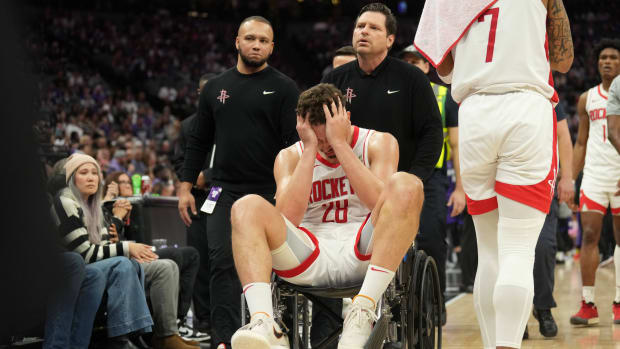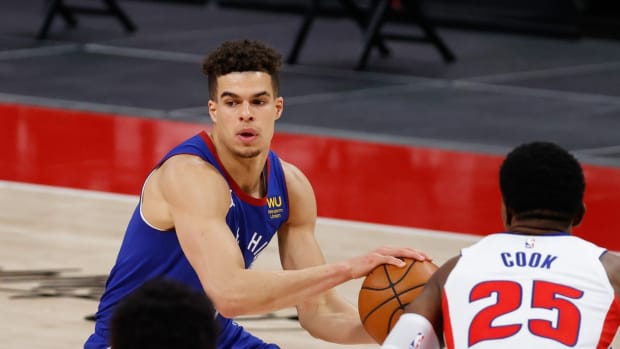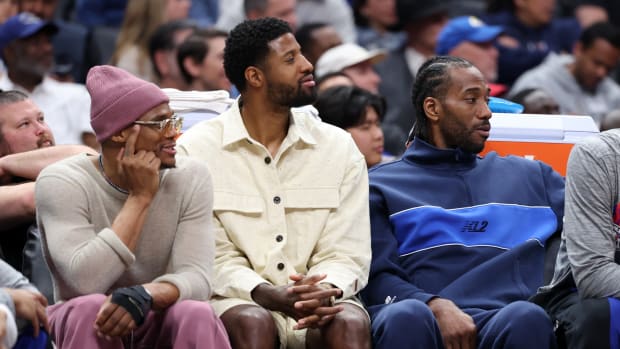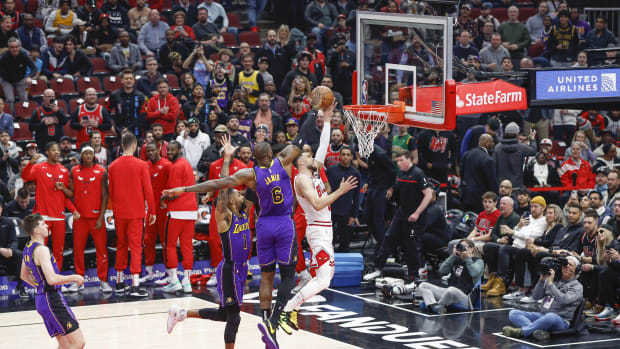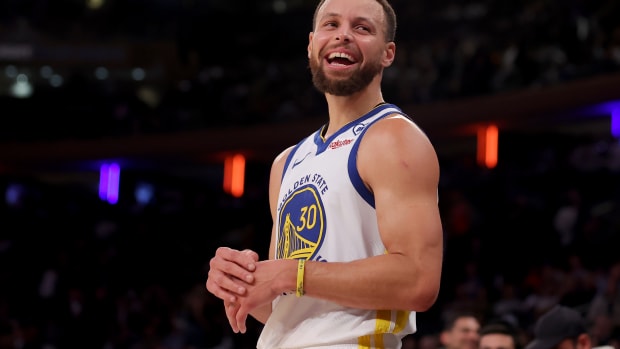NBA trade deadline: Behind the stats
After plenty of trade rumors involving big names like Pau Gasol, Blake Griffin, Dwight Howard and the Atlanta Hawks entire roster, the 2016 NBA trade deadline was limited to a handful of less splashy deals.
Moves involving Jarnell Stokes, Brian Roberts and Shelvin Mack certainly aren’t blockbusters, but players on the move to contenders and potential playoff teams ensured some intrigue—even though, as a sequel, 2016’s deadline was like Men in Black II compared to the wildly entertaining 2015.
The PointAfter team will run down the most impactful deadline deals using intriguing stats and interactive visualizations.
Ben Leibowitz is a writer for PointAfter, a sports data aggregation and visualization website that’s part of the Graphiq network.
More from PointAfter:Best NBA Players by Country | Top 35 NBA All-Star Game MVPs | Making Sense of the Tobias Harris Trade
36.4% From Three
Tobias Harris, the first major domino to fall two days prior to the deadline, was sent from the Orlando Magic to the Detroit Pistons in exchange for Brandon Jennings (expiring contract) and Ersan Ilyasova (non-guaranteed contract in 2016-17). At 6'9" with the ability to step out and shoot threes, Harris seems to fit the mold of a prototypical NBA stretch four.
• SI.com’s NBA trade deadline recap | Every trade that happened on Thursday
However, his career high from beyond the arc is 36.4%—set last season. He’s never come close to that respectable conversion rate from deep before or since.
Was 36.4% from Deep Merely an Aberration for Harris? | PointAfter
With Andre Drummond patrolling the paint, Detroit needs to have a plethora of shooters surrounding him—like Stan Van Gundy’s teams in Orlando led by Dwight Howard. Greg Monroe proved to be a poor fit in that sense, so SVG moved on. If Harris’ lone season as a solid three-point shooter was a fluke, that’s not ideal for Detroit’s outlook.
Of course, as a guy who once averaged 17.3 points and 8.5 rebounds as a 20-year-old for Orlando, there’s clearly plenty of upside here—especially since the fifth-year pro is still only 23 years old.
The Magic, meanwhile, didn’t even get a first-round pick in return.
• Subscribe to get the best of Sports Illustrated delivered right to your inbox
Considering Van Gundy surrendered a first-rounder in a separate deal to land Donatas Motiejunas and Marcus Thornton from the Houston Rockets, that reflects very poorly on Orlando’s front office.
The mustachioed Van Gundy brother puts a lot of stock in outside shooting, and if Harris can’t get the job done, Motiejunas (39% over the past two seasons) and Thornton (35.9% in his career) likely can. That being said, Motiejunas will have to get healthy. He’s missed a whopping 41 games this season, and he’s been absent for 110 out of a possible 301 games thus far in his career.
Motiejunas: Games Played and Missed by Season | PointAfter
55.8% Effective Field Goal Percentage
Another veteran to be moved by the Magic before the deadline was big man Channing Frye. Though he saw a limited role in Orlando (just 17.1 minutes per game this season), Frye’s sizzling shooting couldn’t be cooled down.
The NBA's Top 10 Shooters by eFG% | PointAfter
With a 55.8% effective field goal percentage (a statistic that adjusts for three-point field goals being worth more), Frye ranks fourth in the entire NBA behind reigning MVP Stephen Curry, former Phoenix Suns teammate Jared Dudley and sharpshooter J.J. Redick. Synergy Sports took that impressive stat a step further, via Twitter:
According to Synergy, Frye’s stroke in both catch-and-shoot and pick-and-pop scenarios is virtually automatic. That adept shooting touch will help Cleveland spread the floor on offense, while letting stars like LeBron James and Kyrie Irving operate in the halfcourt.
More Than Half of Frye's Shots are 3s Above the Break | PointAfter
Frye brings adept shooting to the fold as well as playoff experience dating back to when he reached the Western Conference Finals as a key role player on the Suns. He’s a great addition to a team with championship aspirations, but critics will wonder what he brings to the table that Kevin Love doesn’t already.
Comparison: Love and Frye | PointAfter
Love’s a solid outside shooter in his own right, and certainly a much more accomplished rebounder than Frye. Frye is arguably a better defender, but playing him and Love at the same time probably isn’t feasible defensively speaking—especially against small-ball lineups.
• MORE NBA: Winners and losers from the 2016 NBA trade deadline
Cavaliers fans should still be excited about the addition, because Frye is undoubtedly an upgrade over longtime Cavalier big man Anderson Varejao (shipped to Portland). That being said, is Frye really the final piece Cleveland needs to compete against the likes of Golden State or San Antonio?
Top 1-9 Protected
By some impressive degree of dark magic, Suns general manager Ryan McDonough was able to land a first-round draft pick from the Washington Wizards for ornery power forward Markieff Morris. According to AZCentral’s Paul Coro, the pick is top-nine protected. Phoenix will also bring back power forwards Kris Humphries and DeJuan Blair.
Markieff's Post-Marcus Blues are Evident in Year 5 | PointAfter
Morris regressed in a big way on the court this season—he’s shooting 39.7% from the field and 28.9% from three-point territory in addition to the per-game dips. He also got into a shoving match on the bench with teammate Archie Goodwin prior to the All-Star break and has some lingering issues off the court as well. Suns fans have wanted to see Keef get the boot for a while now, and they finally got their wish at the deadline.
For the Wizards, this is a gamble. Morris put himself in the Sixth Man of the Year conversation a season ago, but there are a lot of questions facing both his game and his personality. Is it worth it for the Wizards to surrender a first-round pick to add someone with the hope of making the playoffs as the No. 8 seed (and most likely getting swept by Cleveland)?
On the bright side for the Wizards, Morris has played quite well of late. In February, he’s averaging 20.6 points, 7.6 rebounds and 4.6 assists. If he sustains that through the end of the year, he’ll prove well worth the price tag.
15.8 Minutes Per Game
Last summer, Los Angeles Clippers president of basketball operations Doc Rivers traded forward Matt Barnes and center Spencer Hawes to the Charlotte Hornets for guard Lance Stephenson. “Born Ready” had just endured an abysmal season after flirting with an All-Star berth while playing for Indiana the year prior. The move was a dice roll made with hopes Stephenson would return to form, but he played just 15.8 minutes per contest under Doc—the fewest since his second year in the league.
The Rise and Fall of Stephenson's Minutes | PointAfter
Now that Stephenson has been shipped to the Memphis Grizzlies in exchange for Jeff Green, perhaps he’ll be granted more minutes and return to form with a slower-paced team. He should fit right in with the “Grit-and-Grind” style coined by Tony Allen, Zach Randolph and Co.
As for Green, he’s a solid role player who can experience the occasional 30-plus-point outing, but this move raises similar question to the Cavs adding Frye. Is this really enough for the Clippers to compete with the mighty Spurs or Warriors?
Color me skeptical … at best.
29.6% From Three-Point Land
The final deal from the deadline we’ll discuss is the Oklahoma City Thunder’s addition of guard Randy Foye. Historically a confident sniper from beyond the arc—he’s cashed 37% of his treys in his career—Foye couldn’t find the stroke this season for the Denver Nuggets.
Foye's Shooting Woes Put Him at Career Lows | PointAfter
Based on the numbers, you’d think that OKC was buying low on a savvy veteran, but Denver actually netted D.J. Augustin, Steve Novak (who they’ll likely agree to a buyout with) and OKC was buying low on a savvy veteran, but Denver actually netted D.J. Augustin, Steve Novak (who they’ll likely agree to a buyout with) and two second-round picks. That’s a pretty stellar haul for a bench player.
So why would the Thunder give up two second-rounders and spare parts to get Foye? Well, according to Synergy, Foye’s made 47% of his unguarded catch-and-shoot jumpers. With all of the attention in Oklahoma City on Russell Westbrook and Kevin Durant, Foye could thrive as a spot-up shooter positioning himself around the stars.vi
Randy Foye's 2015-16 Shot Chart | PointAfter
And even though Foye has been laying bricks in the Mile High City, he still shot a highly respectable 40.9% on threes from the left corner. If his role in OKC is to spot up there and wait for his opportunities, he’ll earn his keep with the Western Conference power.






























